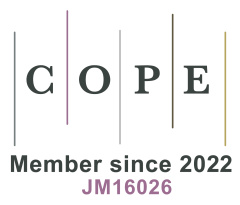Microstructural regulation of seasonal organic nitrate accumulation on pine needle surfaces
Abstract
This study investigates the microregulatory mechanisms governing seasonal variations in particle-bound organic nitrates (PBONs) accumulation on pine needle surfaces. Using scanning electron microscopy, atomic force microscopy, and high-resolution mass spectrometry across five sites in the Changbai Mountain Nature Reserve, we revealed that seasonal transformations in epicuticular wax properties directly control PBON retention. Winter conditions produced maximum wax thickness (5.82 ± 0.47 μm) and PBON concentrations (142.6 ± 18.3 ng/g), while summer showed minimums for both (2.73 ± 0.55 μm; 56.4 ± 9.7 ng/g). We identified temperature as the dominant environmental factor (r = −0.81) with a previously unreported threshold effect at 4.8 ℃, below which PBON accumulation rates accelerate significantly. Structural equation modeling revealed that seasonal conditions influence PBON accumulation through both direct atmospheric pathways and surface-mediated mechanisms. The findings demonstrate that microstructural changes in sampling surfaces are crucial for interpreting seasonal biomonitoring data and understanding pollutant dynamics in forest ecosystems.
References
1. Wang T, Xiang K, Zeng Y, et al. Polycyclic aromatic hydrocarbons (PAHs) in air, foliage, and litter in a subtropical forest: Spatioseasonal variations, partitioning, and litter-PAH degradation. Environmental Pollution. 2023; 328: 121587. doi: 10.1016/j.envpol.2023.121587
2. Ratola N, Amigo JM, Alves A. Comprehensive assessment of pine needles as bioindicators of PAHs using multivariate analysis. The importance of temporal trends. Chemosphere. 2010; 81(11): 1517–1525.
3. Klánová J, Čupr P, Baráková D, et al. Can pine needles indicate trends in the air pollution levels at remote sites? Environmental Pollution. 2009; 157(12): 3248-3254. doi: 10.1016/j.envpol.2009.05.030
4. Holoubek I, Kořı́nek P, Šeda Z, et al. The use of mosses and pine needles to detect persistent organic pollutants at local and regional scales. Environmental Pollution. 2000; 109(2): 283-292. doi: 10.1016/S0269-7491(99)00260-2
5. Augusto L, De Schrijver A, Vesterdal L, et al. Influences of evergreen gymnosperm and deciduous angiosperm tree species on the functioning of temperate and boreal forests. Biological Reviews. 2014; 90(2): 444-466. doi: 10.1111/brv.12119
6. Liu J, Wang Z, Zhao H, et al. Mercury and arsenic in the surface peat soils of the Changbai Mountains, northeastern China: Distribution, environmental controls, sources, and ecological risk assessment. Environmental Science and Pollution Research. 2018; 25(34): 34595–34609.
7. Yang X, Xu X, Liu D, et al. Comparison of contour-based and polygon-based land use change dynamics in China’s nature reserves from 2000 to 2010. Environmental Science and Pollution Research. 2019; 26(10): 9460-9473.
8. Morawska L, Thai PK, Liu X, et al. Applications of low-cost sensing technologies for air quality monitoring and exposure assessment: How far have they gone? Environment International. 2018; 116: 286-299. doi: 10.1016/j.envint.2018.04.018
9. Koper N, Manseau M. Generalized estimating equations and generalized linear mixed-effects models for modelling resource selection. Journal of Applied Ecology. 2009; 46(3): 590-599.
10. Miner JL, Taylor LT, Bells S. Atmospheric polycyclic aromatic hydrocarbon detection in Dayton, Ohio using white pine needles as passive samplers. Atmospheric Pollution Research. 2012; 3(3): 352-361.
11. Kim KW, Lee IJ, Kim CS, et al. Micromorphology of epicuticular waxes and epistomatal chambers of pine species by electron microscopy and white light scanning interferometry. Microscopy and Microanalysis. 2011; 17(1): 118-124.
12. Koch K, Bhushan B, Barthlott W. Multifunctional surface structures of plants: An inspiration for biomimetics. Progress in Materials Science. 2009; 54(2): 137-178. doi: 10.1016/j.pmatsci.2008.07.003
13. Lammel G, Klánová J, Ilić P, et al. Polycyclic aromatic hydrocarbons in air on small spatial and temporal scales – II. Mass size distributions and gas-particle partitioning. Atmospheric Environment. 2010; 44(38): 5022-5027. doi: 10.1016/j.atmosenv.2010.08.001
14. Ringuet J, Albinet A, Leoz-Garziandia E, et al. Reactivity of polycyclic aromatic compounds (PAHs, NPAHs and OPAHs) adsorbed on natural aerosol particles exposed to atmospheric oxidants. Atmospheric Environment. 2012; 61: 15-22. doi: 10.1016/j.atmosenv.2012.07.025
15. Schuster AC, Burghardt M, Alfarhan A, et al. Effectiveness of cuticular transpiration barriers in a desert plant at controlling water loss at high temperatures. AoB PLANTS. 2015; 8. doi: 10.1093/aobpla/plw027
16. Buschhaus C, Jetter R. Composition differences between epicuticular and intracuticular wax substructures: How do plants seal their epidermal surfaces? Journal of Experimental Botany. 2010; 62(3): 841-853. doi: 10.1093/jxb/erq366
17. McMurry PH. A review of atmospheric aerosol measurements. Atmospheric Environment. 2000; 34(12-14): 1959-1999. doi: 10.1016/S1352-2310(99)00455-0
18. Pekney NJ, Davidson CI, Zhou L, et al. Application of PSCF and CPF to PMF-Modeled Sources of PM 2.5 in Pittsburgh. Aerosol Science and Technology. 2006; 40(10): 952-961. doi: 10.1080/02786820500543324
19. Schuster AC, Burghardt M, Riederer M. The ecophysiology of leaf cuticular transpiration: Are cuticular water permeabilities adapted to ecological conditions? Journal of Experimental Botany. 2018; 69(22): 5311-5323.
20. Ratola N, Amigo JM, Alves A. Levels and sources of PAHs in selected sites from Portugal: Biomonitoring with Pinus pinea and Pinus pinaster needles. Archives of Environmental Contamination and Toxicology. 2015; 68(4): 663-677.
21. Bhushan B, Koch K. Selective adsorption of polar and nonpolar pollutants on plant surfaces: A theoretical model based on surface microstructure. Langmuir. 2020; 36(34): 10035-10043.
22. Xu L, Zhang Y, Li H, et al. Dynamic changes in pine needle wax layers and their role in pollutant adsorption: A seasonal study. Environmental Science & Technology. 2023; 57(15): 5923-5933.
Copyright (c) 2025 Author(s)

This work is licensed under a Creative Commons Attribution 4.0 International License.
Copyright on all articles published in this journal is retained by the author(s), while the author(s) grant the publisher as the original publisher to publish the article.
Articles published in this journal are licensed under a Creative Commons Attribution 4.0 International, which means they can be shared, adapted and distributed provided that the original published version is cited.



 Submit a Paper
Submit a Paper
